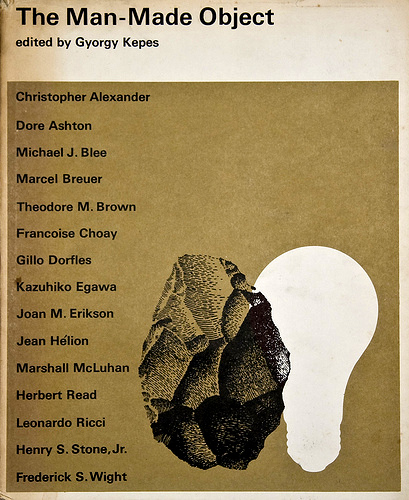Siegfried Giedion: Mechanization Takes Command (1948)
Filed under book | Tags: · agriculture, architecture, furniture, history of technology, industry, machine, movement, philosophy, philosophy of technology, production, technology

“First published in 1948, Mechanization Takes Command is an examination of mechanization and its effects on everyday life. A monumental figure in the field of architectural history, Siegfried Giedion traces the evolution and resulting philosophical implications of such disparate innovations as the slaughterhouse, the Yale lock, the assembly line, tractors, ovens, and “comfort” as defined by advancements in furniture design. A groundbreaking text when originally published, Giedion’s pioneering work remains an important contribution to architecture, philosophy, and technology studies.”
Publisher Oxford University Press, New York, 1948
Third printing, 1970
743 pages
via babyalanturing
Reviews: John E. Sawyer (The Journal of Economic History, 1949), Harry Elmer Barnes (American Journal of Sociology, 1949), William F. Ogburn (The American Historical Review, 1948), Henry Guerlac (American Quarterly, 1949), Donald Horton (American Sociological Review, 1948), Paul Zucker (The Journal of Aesthetics and Art Criticism, 1949), Arthur P. Molella (Technology and Culture, 2002), Tom Vanderbilt (Bookforum, 2010), Bryan E. Norwood (Culture Machine, 2015).
PDF (removed on 2014-4-21 upon request of the University of Minnesota Press)
Comment (1)Gyorgy Kepes (ed.): The Man-Made Object (1966)
Filed under book | Tags: · architecture, art, craft, design, industry, object, painting

Between 1965 and 1966, New York book publisher George Braziller published a six volume series under the title Vision + Value, edited by renowned artist, designer and M.I.T. professor, Gyorgy Kepes.
The aim of the series, “…to stimulate the circulation of ideas, to find channels of communication that interconnect various disciplines and offer us a sense of structure in our 20th century world…,” encouraged interdisciplinary cooperation and sought to bring together the day’s foremost artists, scientists and scholars.
This volume presents a general evaluation of the man-made object as an important environmental factor in the shaping of the mores, feelings, and values. The man-made object, from ornamental trifles to large scale buildings, is here considered not only for its formal and aesthetic aspects, but also for its psychological and sociological impact.
Contributions by Gillo Dorfles, Herbert Read, Joan M. Erikson, Kazuhiko Egawa, Michael J. Blee, Marshall McLuhan, Christopher Alexander, Leonardo Ricci, Marcel Breuer, Theodore M. Brown, Jean Hélion, Henry S. Stone, Jr., Frederick S. Wright, Dore Ashton, Françoise Choay.
Publisher George Braziller, New York, 1966
Vision + Value Series, 5
230 pages
PDF (51 MB, no OCR)
Comment (0)Esther Leslie: Synthetic Worlds: Nature, Art and the Chemical Industry (2005)
Filed under book | Tags: · aesthetics, art, chemistry, history of science, industry, nature, science

Synthetic Worlds considers the remarkable alliance between chemistry and art, taking us from the late eighteenth century to the period immediately following the Second World War. Esther Leslie offers fascinating new insights into the place of the material object and the significance of the natural, the organic, the inorganic and the synthesized in this poetics of science.
Through its dazzling innovations, which began in the nineteenth century, chemistry has granted new colours and surfaces, new substances, coatings and textures to the world. Often they are the result of accidents or the by-products of pollution. Chemistry has also invented simulants and surrogates for naturally occurring materials. Sometimes these developments confounded earlier alchemical and Romantic philosophies of science and nature, but, at other times, dynamic theories of chemical action combined with the emergent chemistry textbook orthodoxy. For example, the colour wheels of Goethe and Philipp Otto Runge, Hegelian theories of a spirit that inhabits dyes and ‘drives’ materials, and Romantic ideas of the weddings of substances influenced the experiments that boosted the successful German chemical industry after the 1840s. In turn, chemistry’s discoveries seeped back into philosophy and art.
Esther Leslie’s Synthetic Worlds considers this and other startling affinities between chemistry, industry, aesthetics and art. Themes include the impact of artificial imitations and synthetics, the location of value, the mutability of substance, chemical fragility and artistic technique, the poetics of the inorganic and pollution, Bauhaus-influenced modulation and patina in art practice, and nationalist narratives of chemical breakthrough.
Publisher Reaktion Books, 2005
Art, Industry and Industrial Studies series
ISBN 1861892489, 9781861892485
280 pages
review (Sophia Efstathiou, Hyle)
Comment (0)
